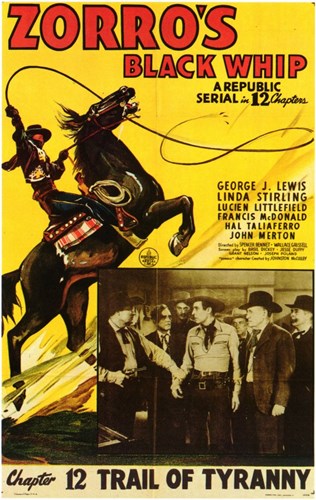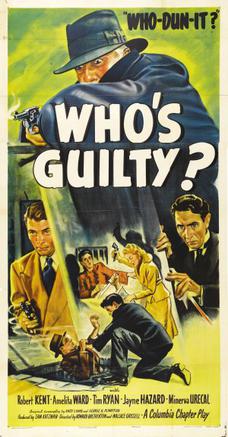
The Shadow is a fictional character created by American magazine publishers Street & Smith and writer Walter B. Gibson. Originally created to be a mysterious radio show narrator, and developed into a distinct literary character in 1931 by Gibson, The Shadow has been adapted into other forms of media, including American comic books, comic strips, serials, video games, and at least five feature films. The radio drama included episodes voiced by Orson Welles.

The Masked Marvel (1943) is a 12-chapter film serial created by Republic Pictures, who produced many other well known serials. It was Republic's thirty-first serial, of the sixty-six they produced.

Mysterious Doctor Satan is a 1940 American film serial directed by William Witney and John English. Produced by Republic Pictures, the serial stars Edward Ciannelli, Robert Wilcox, William Newell, C. Montague Shaw, Ella Neal, and Dorothy Herbert. The title of the serial is derived from that of its chief villain.

Zorro's Black Whip is a 1944 12-chapter film serial by Republic Pictures starring Linda Stirling. The film was made after the 1940 20th Century-Fox remake of The Mark of Zorro in order to capitalize on it. Republic was not able to use the character of Zorro himself, however, and despite the title, the hero(ine) is called The Black Whip throughout.

Drums of Fu Manchu (1940) is a 15-chapter Republic serial film based on the character created by Sax Rohmer. Though using the title of the ninth novel in the series, it actually is based on numerous elements from throughout the series to that point, cherry-picked by the writers. It starred Henry Brandon, William Royle and Robert Kellard. It was directed by the serial team of William Witney and John English and is often considered one of the best serial films ever made.

A masked villain, also seen as masked mystery villain, is a stock character in genre fiction. It was developed and popularized in movie serials, beginning with The Hooded Terror in The House of Hate, (1918) the first fully-costumed mystery villain of the movies, and frequently used in the adventure stories of pulp magazines and sound-era movie serials in the early twentieth century, as well as postmodern horror films where the character "hides in order to claim unsuspecting victims". They can also appear in crime fiction to add to the atmosphere of suspense and suspicion. It is used to engage the readers or viewers by keeping them guessing just as the characters are, and suspension by drawing on the fear of the unknown. The "Mask" need not be literal, referring more to the subterfuge involved.

Darkest Africa (1936) is a Republic movie serial. This was the first serial produced by Republic Pictures and was a loose sequel to a Mascot Pictures serial called The Lost Jungle, also starring Clyde Beatty. Mascot, and other companies, had been taken over in 1935 by Consolidated Film Laboratories and merged to become Republic. Producer Nat Levine was formerly the owner of Mascot Pictures.

Dick Tracy vs. Crime, Inc. (1941) is a Republic Movie serial based on the Dick Tracy comic strip. It was directed by the team of William Witney and John English with Ralph Byrd reprising his role from the earlier serials. It was the last of the four Dick Tracy serials produced by Republic, although Ralph Byrd went on to portray the character again in two features and on television.

King of the Rocket Men is a 1949 12-chapter movie serial from Republic Pictures, produced by Franklin Adreon, directed Fred C. Brannon, that stars Tristram Coffin, Mae Clarke, Don Haggerty, House Peters, Jr., James Craven, and I. Stanford Jolley.

Captain America is a 1944 Republic black-and-white 15-chapter serial film loosely based on the Timely Comics character Captain America. It was the last Republic serial made about a superhero. It also has the distinction of being the most expensive serial that Republic ever made. It stands as the first theatrical release connected to a Marvel character. The film was re-released in 1953 and it was released in Turkey in popular before the release of the original comics, Turkish Captain America films was also produced such as 1968 film Binbaşı Tayfun and 1973 film 3 Dev Adam. It was the first live-action rendition of a Marvel character before Captain America live action segmnet by Arthur Pierce of the 1966 television series The Marvel Super Heroes in 1966, and Spider-Man appeared in the Spidey Super Stories segment of the children's television series The Electric Company in 1974.
Riders of Death Valley is a 1941 American Western film serial from Universal Pictures. It was a high budget serial with an all-star cast led by Dick Foran and Buck Jones. Ford Beebe and Ray Taylor directed. It also features Lon Chaney Jr. in a supporting role as a villainous henchman as well as Noah Beery Jr., Charles Bickford, Guinn "Big Boy" Williams, Monte Blue, Roy Barcroft, Richard Alexander and Glenn Strange.

Bruce Gentry – Daredevil of the Skies (1949) is a 15-episode Columbia Pictures movie serial based on the Bruce Gentry comic strip created by Ray Bailey. It features the first cinematic appearance of a flying saucer, as the secret weapon of the villainous Recorder.

The Last Frontier is an American Pre-Code 12-chapter serial, distributed by RKO Radio Pictures in 1932. The story was based on the novel of the same name by Courtney Ryley Cooper.

The Spider's Web is a 1938 Columbia Pictures movie serial based on the popular pulp magazine character The Spider. It was the fifth of the 57 serials released by Columbia.

The Spider Returns is a 1941 15-chapter Columbia movie serial based on the pulp magazine character The Spider. It was the fourteenth of the 57 serials released by Columbia and a sequel to their 1938 serial The Spider's Web. The first episode runs 32 minutes, while the other 14 are approximately 17 minutes each.

The Green Archer is the 12th serial released by Columbia Pictures. It was based on Edgar Wallace's 1923 novel The Green Archer, which had previously been adapted into the silent serial of the same name in 1925 by Pathé Exchange.

The Secret Code (1942) was the 19th serial released by Columbia Pictures. It features the masked hero "The Black Commando" facing Nazi saboteurs, inspired by Republic Pictures' successful Spy Smasher serial of the same year. The chapters of this serial each ended with a brief tutorial in cryptography.

Who's Guilty? is a 1945 American film serial. It was the 28th of 57 serials released by Columbia Pictures. Who's Guilty? was a rare attempt at a whodunit mystery film in serial form. The serial's villain was designed to look like The Shadow on the poster. The film co-starred some well-known character actors, such as Charles Middleton, Wheeler Oakman, and Minerva Urecal. Robert Kent played the lead role of Detective Bob Stewart.

Mysterious Island is a 1951 American 15-chapter movie serial from Columbia Pictures, the studio's 46th, that stars Richard Crane, Marshall Reed, Karen Randle, and Ralph Hodges. It is an adaptation of Jules Verne's 1874 novel, The Mysterious Island. As in the original story, which was Verne's follow-up to Twenty Thousand Leagues Under the Seas, this serial is set in 1865. However, Columbia's screenwriters added alien Mercurians as an additional set of villains. The serial has been labeled a space opera version of Verne's novel.

















